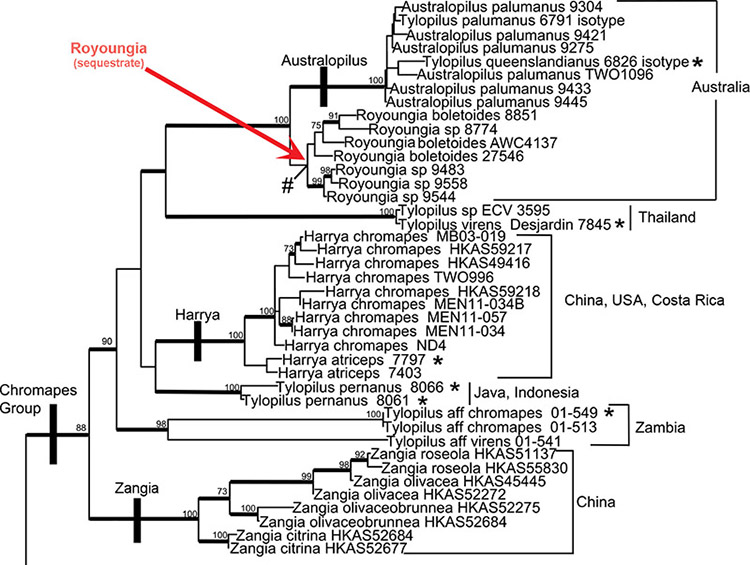Harrya & Australopilus are new genera allied to Zangia & Royoungia
Australian Systematic Botany 25(6): 418-431. 2012.
Background: Boletus chromapes was described by Charles Frost (1874), a shoemaker in Brattleboro, Vermont, USA. Modern placement in Tylopilus or in Leccinum has been equivocal (Singer 1947, 1986; Smith & Thiers 1968), because emphasis was given to either stipe ornamentation (Singer) or spore color (Smith & Thiers).
Molecular phylogenetic inference provides a new perspective on placement of B. chromapes in the Boletaceae well away from either Leccinum or Tylopilus. The partial phylogram is based on a 2-gene (nuc-LSU, tef1) dataset (engineered by M. Nuhn). The tree topology corresponds to the optimal maximum likelihood tree calculated by RAxML. Support values > 70% bootstrap and 0.95 posterior probability (bold lines) are shown. Thus, two new genera Harrya (with 2 species) & Australopilus are described with affinities to the sequestate Royoungia and the epigeous Zangia, the latter so far only known from S China. Unnamed clades from Zambia, Thailand, and Indonesia are currently recognized as well.
Frost C.C. 1874. Catalogue of boleti of New England, with descriptions of new species. Bull Buffalo Soc Nat Sci 2: 100–105.
Singer, R. 1947. The Boletoideae of Florida. The Boletineae of Florida with notes on extralimital species III. Am Midl Nat 37:1–135.
____. 1986. The Agaricales in Modern Taxonomy. Germany. 981 p.
Smith, A.H. & H.D. Thiers. 1968) Notes on boletes – I, 1. The generic position of Boletus subglabripes and Boletus chromapes 2. A comparison of four species of Tylopilus. Mycologia 60: 943–954.
